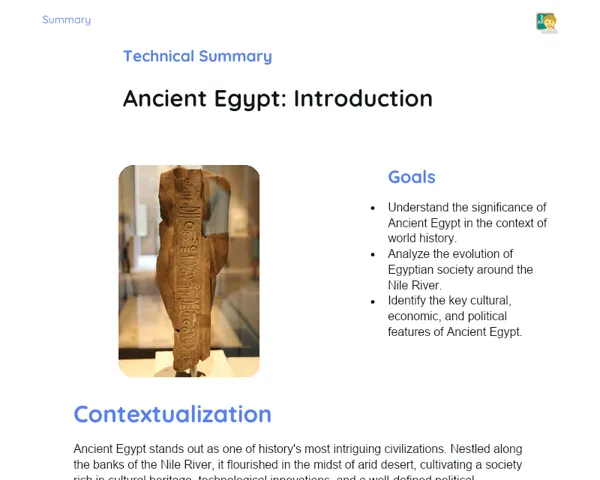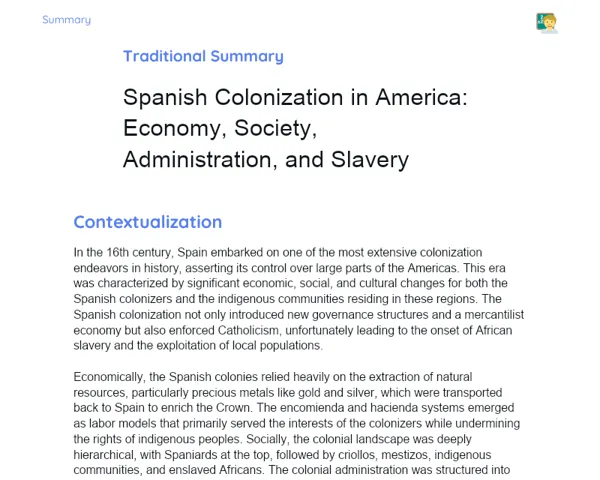Socioemotional Summary Conclusion
Goals
1. Understand the historical context of independence movements in Latin America, exploring their causes and consequences.
2. Recognize and connect with the emotions tied to historical events, both in key figures and within ourselves.
3. Discuss the social and geopolitical ramifications of independence movements in Latin America, encouraging responsible decision-making and heightened social awareness.
Contextualization
Did you know that the independence movements in Latin America were not merely military confrontations, but also profound emotional struggles? Imagine the whirlwind of hope, fear, and resilience that the people of that era experienced while fighting for a future full of uncertainties. As we explore these significant events, we will not only grasp the historical timeline but also the human emotions that influenced our continent. 🌎✨
Exercising Your Knowledge
Internal and External Causes of Independence
Independence movements in Latin America arose from a blend of internal and external factors, including the discontent of Creole elites with colonial governance and the impact of global revolutionary ideologies, like the French and American Revolutions. These causes reveal a strong yearning for change and self-governance, mixed with trepidation about what lay ahead.
-
Dissatisfaction of Creole Elites: The Creole elites, the local descendants of European colonizers, were dissatisfied with the control imposed by the colonial powers. This sense of dissatisfaction sparked the independence movements.
-
Influence of External Movements: The revolutionary zeal of the French and American Revolutions deeply inspired Latin American colonies. Their principles of liberty, equality, and fraternity ignited a shared desire for freedom and social justice.
-
Internal Social Tensions: The various social groups—including indigenous communities, African slaves, and mestizos—formed a volatile mixture that stoked revolutionary passions. The fight for improved living conditions and equal rights was a significant driver for these movements.
Key Movements and Leaders
The path to independence in Latin America was paved by remarkable leaders who, fueled by a fervent sense of justice and a yearning for freedom, navigated their nations through turbulent conflicts. Figures such as Simón Bolívar and José de San Martín faced not just military challenges but also emotional dilemmas that influenced their leadership.
-
Simón Bolívar: Referred to as 'The Liberator', Bolívar led campaigns that liberated multiple South American countries from colonial rule. His vision for a unified Latin America was deeply intertwined with his feelings of hope and frustration.
-
José de San Martín: A pivotal leader, San Martín was instrumental in the independence of Argentina, Chile, and Peru. His bravery and unwavering commitment illustrate how positive emotions can drive remarkable accomplishments.
-
Miguel Hidalgo: A significant figure in Mexico's independence, Father Hidalgo sparked the movement with his legendary 'Cry of Dolores'. His courage was motivated by a profound sense of social justice and concern for the marginalized.
Conflicts and Geopolitical Reorganization
The journey towards independence in Latin America was characterized by fierce armed struggles that disrupted the traditional colonial vice-kingdoms and led to the emergence of new nations. These conflicts were not solely physical but also emotional, encompassing fear, hope, and resilience.
-
Wars of Independence: The wars during this era were brutal, leading to significant human and material losses. These struggles embodied the courage and desperation of the individuals involved.
-
New Geopolitical Map: Independence saw the formation of several new nation-states, dramatically transforming the political landscape of the region. This structural reorganization represented a fresh start, filled with both uncertainties and opportunities.
-
Impact on International Relations: The newly formed nations faced the task of crafting their identities and gaining international recognition, confronting emotional hurdles related to acceptance and legitimacy.
Key Terms
-
Independence: The status of being free and self-governing, without reliance on another authority.
-
Creole Elite: A social class comprising descendants of Europeans in the colonies, endowed with economic and political privileges.
-
French Revolution: A revolutionary movement in France at the end of the 18th century, which catalyzed political and social changes globally.
-
Simón Bolívar: A Venezuelan military and political figure instrumental in liberating several South American nations from colonial domination.
-
José de San Martín: An Argentine general who played a critical role in the independence movements of Argentina, Chile, and Peru.
-
Cry of Dolores: A historic proclamation by Father Miguel Hidalgo in 1810 that marked the beginning of Mexico's struggle for independence.
For Reflection
-
How did the emotions experienced by independence leaders influence their decision-making and actions during liberation struggles?
-
In what ways do internal conflicts and social disparities mirror the emotions of diverse social classes during the wars for independence?
-
How can we draw lessons from the courage, hope, and resilience highlighted by the independence movements in Latin America to tackle our own personal and social challenges?
Important Conclusions
-
Independence movements in Latin America arose from a combination of internal and external factors, revealing a profound longing for change and self-determination.
-
Visionaries like Simón Bolívar, José de San Martín, and Miguel Hidalgo achieved remarkable feats fueled by strong feelings of justice, hope, and courage.
-
The violent conflicts and subsequent geopolitical restructuring resulting from these independence movements gave rise to new nation-states and established enduring legacies that continue to shape modern Latin America.
Impacts on Society
The echoes of Latin America's independence movements remain strong in today's society, influencing national identities and political dynamics in the region. The ongoing quest for freedom and justice inspires contemporary social and political movements, echoing the resilience and hope found in history. For us, this means that the emotional struggles faced by independence leaders are relevant to our daily challenges, as we encounter our own battles for justice and equity.
Emotionally connecting with the tales of bravery and sacrifice exhibited by independence leaders can motivate us to address our difficulties with increased resolve and empathy. By acknowledging the shared hope and courage that fueled these leaders, we can channel these emotions constructively in our lives, nurturing heightened social responsibility and awareness in our everyday choices. 🌟✊
Dealing with Emotions
To navigate the emotions that arise while studying this topic, I suggest an exercise based on the RULER method. First, recognize the emotions that surface as you engage with the independence movements in Latin America—be it curiosity, empathy, or even sadness regarding the conflicts. Next, understand the origins of these emotions and how they impact your perspective on the topic. Name the emotions accurately; for instance, identifying whether you feel empathy for the historical leaders or indignation over social injustices. Express these feelings suitably, perhaps through writing or discussions with your classmates. Lastly, regulate these emotions by employing mindfulness techniques, such as guided meditation, to maintain emotional equilibrium while studying. 📚🧠
Study Tips
-
Construct a visual timeline of significant events and leaders involved in the Latin American independence movements to help contextualize and memorize the details.
-
Utilize films, documentaries, and biographies focused on independence leaders and historical movements to make your study sessions more engaging.
-
Form study groups to explore the emotions and viewpoints of historical figures, fostering a vibrant exchange of ideas that enhances comprehension and develops socio-emotional skills.



